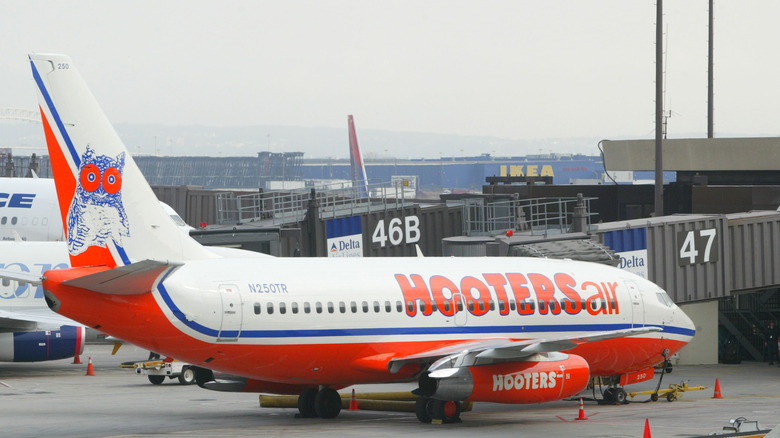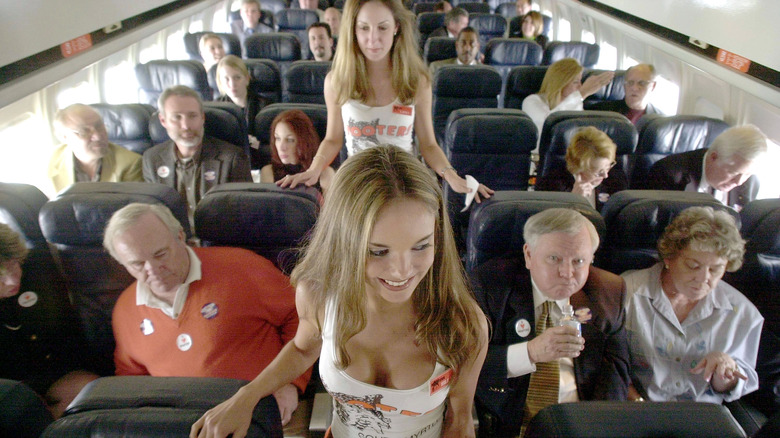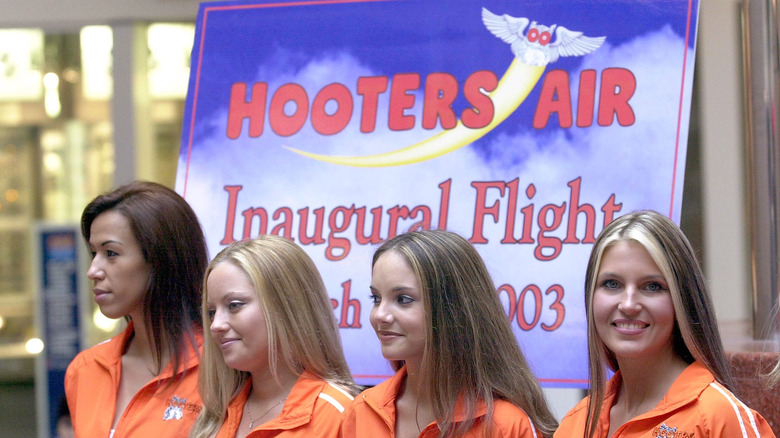The Only Restaurant That Ever Got Its Own Airline (And Why It Failed Pretty Fast)
It was 2003, the new millennium was well underway, and businesses were seeking opportunities to expand and accelerate their growth — anything seemed possible. Internet start-ups like YouTube and Amazon were kicking off, and the first and only restaurant ever got its own airline: Hooters. Unfortunately for them, it failed pretty fast.
Surprisingly enough, the airline, "Hooters Air," initially took off successfully, and the owner, Robert Brooks, thought this would be a game-changing venture for brand exposure with a billboard in the sky. It's not a bad idea — who wouldn't look up into the sky, see those famous double-orange-os, and not consider chicken wings, fries, and beer for dinner?
Brooks acquired Pace Airlines and converted it into Hooters Air. The South Carolina-based airline catered to golfers hoping to visit Myrtle Beach's 100-plus professional golf courses. Hooters Air had flat rate deals of $129 non-stop, each way, on domestic travel to 15 destinations in the U.S., using slogans like "fly a mile high with us" to top it off. The airline's fleet, which at its peak included seven aircraft, featured the Hooters logo and the familiar orange and white color scheme.
Benefits and unconventional in-flight services included four flight attendants (professionally dressed), extra legroom in the "club class" comparable to that of business class, and two Hooters girls in iconic company uniforms to entertain and serve. They performed duties like safety procedures, serving meals and drinks, selling Hooters merchandise, and hanging out with the passengers. Where did it all go wrong?
The downfall of Hooters Air
Despite its initial popularity and media attention, Hooters Air faced challenges from the start. One of the main obstacles was the airline's niche market. While the Hooters brand had a strong following, translating this success into the airline industry proved difficult. The concept appealed more to leisure travelers than to business travelers or families, which significantly limited its customer base.
The airline's "fun" marketing strategy, while successful in generating initial interest, was not enough to sustain long-term growth. The novelty of the Hooters brand in the sky steadily wore off, and the airline struggled to compete with larger, more established carriers, such as Southwest Airlines and JetBlue, that offered more routes and frequent flyer programs.
Moreover, the airline industry in the early 2000s was facing some turbulence. In the aftermath of the September 11 attacks, people were more hesitant to fly. Fuel prices were high after the devastating Hurricane Katrina and Hurricane Rita, causing the airline to struggle to maintain profitability amid rising operational costs. All of this caused consistent difficulty in achieving a high load factor (the percentage of seats filled on each flight).
There was also a case of bad publicity. In 2005, Hooters Air was sued by three former aviation students of Southern Illinois University who claimed that the airline stole their business plan college project and never compensated them. The lawsuit was dismissed, but the publicity stunt didn't do any good for the airline. Around the same year, 2005, many Hooters Air flights were hooting off mostly empty.
Three years in the sky and $40 million later: lessons learned
After only three years, on January 9, 2006, Hooters Air suspended their services. As of April 17, 2006, they ceased operations altogether. All in all, Hooters Air lost $40 million — not inclusive of the lawsuit's legal fees or any legal fees incurred by Robert Brooks while launching the airline. Though Hooters Air was short-lived, its story remains a fascinating chapter in the history of aviation. Differentiating oneself is no easy feat in the highly competitive and cost-sensitive airline industry. The venture also highlights how important it is to have a sustainable business model that can withstand economic pressures and shifts in consumer behavior.
The rise and fall of Hooters Air serves as a cautionary tale for the airline industry about the risks of niche marketing and the limitations of brand extension. For consumers, it remains a curious footnote from the early 2000s, a reminder of a time when an airline dared to combine wings (both of the avian and aircraft varieties) in an unforgettable flying experience. Although the airline failed pretty fast, Hooters still has more than 400 restaurant locations around the world, from the U.S. to Japan, the Czech Republic to Brazil, and beyond — no round-trip necessary.


